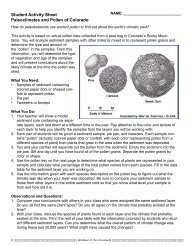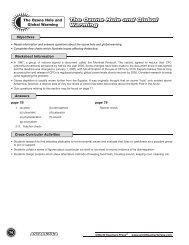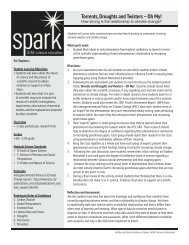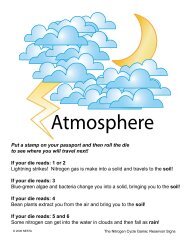Earth's Global Electric Circuit - Spark - University Corporation for ...
Earth's Global Electric Circuit - Spark - University Corporation for ...
Earth's Global Electric Circuit - Spark - University Corporation for ...
You also want an ePaper? Increase the reach of your titles
YUMPU automatically turns print PDFs into web optimized ePapers that Google loves.
Earth’s<br />
Ionosphere<br />
The Ionosphere - Earth’s atmosphere contains a series of regions that<br />
have a relatively large number of electrically charged atoms and molecules.<br />
As a group, these regions are collectively called the ionosphere and they<br />
extend from about 35 to more than 1,000 miles above Earth’s surface<br />
(56 to 1610 km) from the middle of the mesosphere through the entire<br />
thermosphere and further.<br />
Interestingly, the existence of an electrically-conducting region of the<br />
atmosphere was not confirmed until the first decade of the 20th Century. Its<br />
discovery ushered in the long-distance transmission of radio waves by the<br />
ionosphere’s reflective properties, which acts like a mirror in the sky making<br />
the transmission of radio waves possible.<br />
The ionosphere is made up of three horizontal regions commonly referred<br />
to as regions D, E, and F. Region D extends from approximately 40 to 60<br />
miles (64 to 96 km); Region E extends from 60 to 80 miles (96 to 129 km);<br />
and Region F extends from about 100 to 1,000 miles (160 to 1610 km) or<br />
more above Earth’s surface. The ionosphere reaches its maximum density of<br />
charged particles in this last region, Region F, from 125 to 375 miles (201 to<br />
603 km) altitude. It then decreases in density with height.<br />
It is in constant flux over time and place in both its charged particle density<br />
and its structure. Its variability is due to the variability of the Sun. Not only<br />
does the Sun’s energy change throughout a 24-hour period, the Sun’s x-ray<br />
and ultraviolet emissions also change and impact the ionosphere due to the<br />
Sun’s highly variable 11-year sunspot cycle, changes in the Sun’s<br />
rotation, solar flares, and more. The ionosphere not only varies greatly with<br />
time (sunspot cycle, seasonally, and diurnally), but also by geographical<br />
location (polar, auroral zones, mid-latitudes, and equatorial regions), and with<br />
certain solar-related ionospheric disturbances.<br />
The ionosphere is that part of the upper atmosphere where free electrons<br />
occur in sufficient density to have an appreciable influence on the<br />
propagation of radio frequency electromagnetic waves. This ionization<br />
depends primarily on the Sun and its activity. Ionospheric structures and<br />
peak densities in the ionosphere vary greatly with time (sunspot cycle,<br />
seasonally, and diurnally), with geographical location (polar, auroral zones,<br />
mid-latitudes, and equatorial regions), and with certain solar-related<br />
ionospheric disturbances.<br />
The major part of the ionization is produced by solar X-ray and ultraviolet<br />
radiation, and by radiation from the solar wind of the Sun and space rays.<br />
The most noticeable effect is seen as the Earth rotates with respect to<br />
the Sun; ionization increases in the sunlit atmosphere and decreases on<br />
the shadowed side. Although the Sun is the largest contributor toward<br />
the ionization, cosmic rays make a small contribution. Any atmospheric<br />
disturbance affects the distribution of the ionization.<br />
The ionosphere is a dynamic ever-changing system controlled by many<br />
things including acoustic motions of the atmosphere, electromagnetic<br />
emissions, and variations in the geomagnetic field. Because of its extreme<br />
sensitivity to atmospheric changes, the ionosphere is a very sensitive<br />
monitor of atmospheric events. The most accurate way of measuring the<br />
ionosphere is with a ground-based ionosonde, which records data as<br />
ionograms.<br />
Earth’s<br />
Ionosphere<br />
Interestingly, Region F is also an exporter of ions and electrons. Ions are<br />
neutral atoms that have become electrically charged by the addition or loss<br />
of one or more electrons. Electrons are sub-atomic particles within atoms<br />
that carry a negative charge. An atom that gains an electron, there<strong>for</strong>e, is<br />
negative, while an atom that looses an electron is positive. Protons are the<br />
corresponding positively charged particles within all atoms.<br />
As the Sun’s energy reaches the ionosphere in the day, the ionosphere<br />
expands and carries ions upward into an area surrounding our planet called<br />
the magnetosphere. As the Sun sets and night arrives, the ionopshere cools<br />
and contracts, which draws lost ions and electrons back to the ionosphere<br />
until the Sun’s return each dawn. Here, the atmosphere crackles with electric<br />
current, and dances with curtains of light over the Poles due to earthward<br />
solar storm’s solar plasma.<br />
A NASA satellite orbits high at the<br />
outskirts of Earth’s atmosphere and<br />
captures beautiful green curtains of<br />
light dancing due to auroral currents.<br />
Auroras – or northern and southern<br />
lights – are one in the same. They are<br />
caused by highly charged particles<br />
hurled toward Earth’s atmosphere<br />
following some solar storms.<br />
Source: NASA<br />
10.<br />
11.















